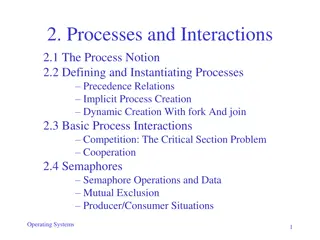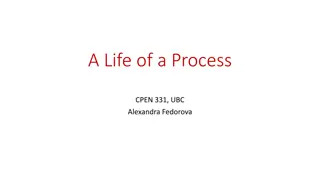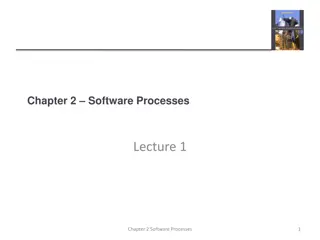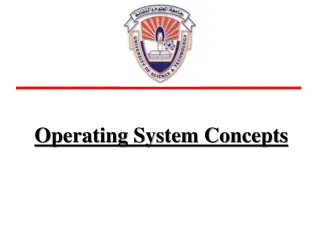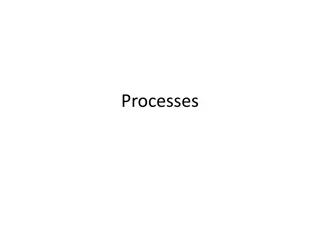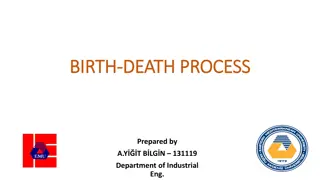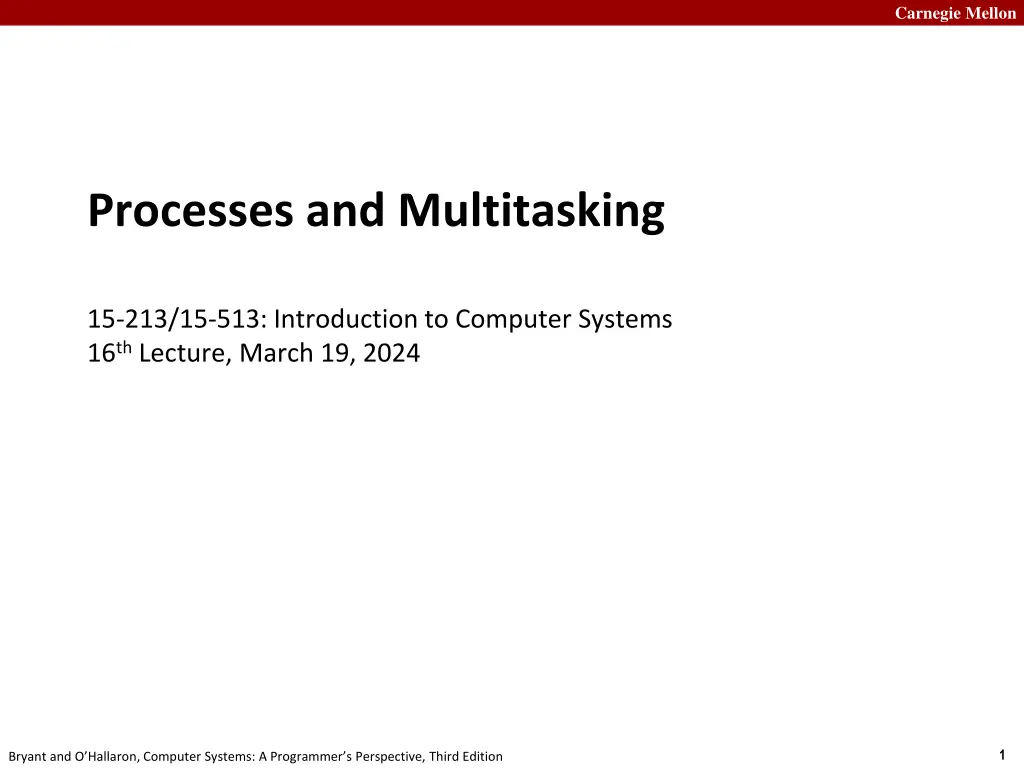
Understanding Carnegie Mellon Processes and Multitasking: Computer Systems Overview
Explore the evolution of Carnegie Mellon processes, from early batch jobs to modern multiprocessing systems. Learn about memory management, system calls, and the efficient sharing of computer resources, as depicted in "Computer Systems: A Programmer’s Perspective" by Bryant and O'Hallaron.
Download Presentation

Please find below an Image/Link to download the presentation.
The content on the website is provided AS IS for your information and personal use only. It may not be sold, licensed, or shared on other websites without obtaining consent from the author. If you encounter any issues during the download, it is possible that the publisher has removed the file from their server.
You are allowed to download the files provided on this website for personal or commercial use, subject to the condition that they are used lawfully. All files are the property of their respective owners.
The content on the website is provided AS IS for your information and personal use only. It may not be sold, licensed, or shared on other websites without obtaining consent from the author.
E N D
Presentation Transcript
Carnegie Mellon Processes and Multitasking 15-213/15-513: Introduction to Computer Systems 16thLecture, March 19, 2024 1 Bryant and O Hallaron, Computer Systems: A Programmer s Perspective, Third Edition
Carnegie Mellon Today Processes System Calls Process Control Shells 2 Bryant and O Hallaron, Computer Systems: A Programmer s Perspective, Third Edition
Carnegie Mellon Earliest days: One batch job at a time IBM 704 at Langley Research Center (NASA), 1957 https://commons.wikimedia.org/w/index.php?curid=6455009 3 Bryant and O Hallaron, Computer Systems: A Programmer s Perspective, Third Edition
Carnegie Mellon How can many people share one computer efficiently? 4 Bryant and O Hallaron, Computer Systems: A Programmer s Perspective, Third Edition
Carnegie Mellon Multiprocessing Memory Memory Memory Stack Heap Data Stack Heap Data Stack Heap Data Code Code Code CPU Registers CPU Registers CPU Registers Computer runs many processes simultaneously Applications for one or more users Web browsers, email clients, editors, Background tasks Monitoring network & I/O devices 5 Bryant and O Hallaron, Computer Systems: A Programmer s Perspective, Third Edition
Carnegie Mellon Multiprocessing Example Running program top on hammerheadshark System has 425 tasks , 7 of which are active Identified by Process ID (PID), user account, command name 6 Bryant and O Hallaron, Computer Systems: A Programmer s Perspective, Third Edition
Carnegie Mellon Processes Memory Definition: A process is an instance of a running program. One of the most profound ideas in computer science Not the same as program or processor Stack Heap Data Code CPU Registers Process provides each program with two key abstractions: Private address space Each program seems to have exclusive use of main memory. Provided by kernel mechanism called virtual memory Logical control flow Each program seems to have exclusive use of the CPU Provided by kernel mechanism called context switching 7 Bryant and O Hallaron, Computer Systems: A Programmer s Perspective, Third Edition
Carnegie Mellon Control Flow Processors do only one thing: From startup to shutdown, each CPU core simply reads and executes a sequence of machine instructions, one at a time * This sequence is the CPU s control flow (or flow of control) Physical control flow <startup> inst1 inst2 inst3 instn <shutdown> Time * many modern CPUs execute several instructions at once, out of program order, but this is invisible to the programmer 8 Bryant and O Hallaron, Computer Systems: A Programmer s Perspective, Third Edition
Carnegie Mellon Context Switching Processes are managed by a shared chunk of memory- resident OS code called the kernel Important: the kernel is not a separate process, but rather runs as part of some existing process. Control flow passes from one process to another via a context switch Process A Process B user code context switch kernel code Time user code context switch kernel code user code 9 Bryant and O Hallaron, Computer Systems: A Programmer s Perspective, Third Edition
Carnegie Mellon Context Switching (Uniprocessor) Memory Stack Heap Data Stack Heap Data Stack Heap Data Code Code Saved registers Code Saved registers CPU Registers Single processor executes multiple processes concurrently Process executions interleaved (multitasking) Address spaces managed by virtual memory system (like last week) Register values for nonexecuting processes saved in memory 10 Bryant and O Hallaron, Computer Systems: A Programmer s Perspective, Third Edition
Carnegie Mellon Context Switching (Uniprocessor) Memory Stack Heap Data Stack Heap Data Stack Heap Data Code Saved registers Code Saved registers Code Saved registers CPU Registers Save current registers in memory 11 Bryant and O Hallaron, Computer Systems: A Programmer s Perspective, Third Edition
Carnegie Mellon Context Switching (Uniprocessor) Memory Stack Heap Data Stack Heap Data Stack Heap Data Code Saved registers Code Saved registers Code Saved registers CPU Registers Schedule next process for execution 12 Bryant and O Hallaron, Computer Systems: A Programmer s Perspective, Third Edition
Carnegie Mellon Context Switching (Uniprocessor) Memory Stack Heap Data Stack Heap Data Stack Heap Data Code Saved registers Code Saved registers Code Saved registers CPU Registers Load saved registers and switch address space (context switch) 13 Bryant and O Hallaron, Computer Systems: A Programmer s Perspective, Third Edition
Carnegie Mellon Context Switching (Multicore) Memory Stack Heap Data Stack Heap Data Stack Heap Data Code Code Code Saved registers CPU Registers CPU Registers Multicore processors Multiple CPUs on single chip Share main memory (and some caches) Each can execute a separate process Scheduling of processors onto cores done by kernel 14 Bryant and O Hallaron, Computer Systems: A Programmer s Perspective, Third Edition
Carnegie Mellon User View of Concurrent Processes Two processes run concurrently (are concurrent) if their execution overlaps in time Otherwise, they are sequential Appears as if concurrent processes run in parallel with each other This means they can interfere with each other (more on that in a couple weeks) A and B concurrent Process A Process B Process C A and C concurrent Time B and C sequential 15 Bryant and O Hallaron, Computer Systems: A Programmer s Perspective, Third Edition
Carnegie Mellon Traditional (Uniprocessor) Reality Only one process runs at a time A and B execution is interleaved, not truly concurrent Similarly for A and C Still possible for A and B / A and C to interfere with each other Process A Process B Process C Time 16 Bryant and O Hallaron, Computer Systems: A Programmer s Perspective, Third Edition
Carnegie Mellon How does the kernel take control? The CPU executes instructions in sequence We don t write now run kernel code in our programs Or do we?? Physical control flow <startup> inst1 inst2 inst3 instn <shutdown> <kernel entry> insta instb instc <kernel exit> Time syscall 17 Bryant and O Hallaron, Computer Systems: A Programmer s Perspective, Third Edition
Carnegie Mellon Today Processes System Calls Process Control Shells 18 Bryant and O Hallaron, Computer Systems: A Programmer s Perspective, Third Edition
Carnegie Mellon System Calls Whenever a program wants to cause an effect outside its own process, it must ask the kernel for help // fopen.c FILE *fopen(const char *fname, const char *mode) { int flags = mode2flags(mode); if (!flags) return NULL; int fd = open(fname, flags, DEFPERMS); if (fd == -1) return NULL; return fdopen(fd, mode); } Examples: Read/write files Get current time Allocate RAM (sbrk) Create new processes // open.S .global open open: mov $SYS_open, %eax syscall cmp $SYS_error_thresh, %rax ja __syscall_error ret 19 Bryant and O Hallaron, Computer Systems: A Programmer s Perspective, Third Edition
Carnegie Mellon All the system calls accept accept4 acct add_key adjtimex bind bpf brk capget capset chdir chroot clock_adjtime clock_getres clock_gettime clock_nanosleep clock_settime clone clone3 close close_range connect copy_file_range delete_module dup dup3 epoll_create1 epoll_ctl epoll_pwait epoll_pwait2 eventfd2 execve execveat exit exit_group faccessat faccessat2 fallocate fanotify_init fanotify_mark fchdir fchmod fchmodat fchown fchownat fdatasync fgetxattr finit_module flistxattr flock fremovexattr fsconfig fsetxattr fsmount fsopen fspick fsync futex futex_waitv get_mempolicy get_robust_list getcpu getcwd getdents64 getegid geteuid getgid getgroups getitimer getpeername getpgid getpid getppid getpriority getrandom getresgid getresuid getrlimit getrusage getsid getsockname getsockopt gettid gettimeofday getuid getxattr init_module inotify_add_watch inotify_init1 inotify_rm_watch io_cancel io_destroy io_getevents io_pgetevents io_setup io_submit io_uring_enter io_uring_register io_uring_setup ioctl ioprio_get ioprio_set kcmp kexec_file_load kexec_load keyctl kill landlock_add_rule landlock_create_ruleset landlock_restrict_self lgetxattr linkat listen listxattr llistxattr lookup_dcookie lremovexattr lsetxattr madvise mbind membarrier memfd_create memfd_secret migrate_pages mincore mkdirat mknodat mlock mlock2 mlockall mount mount_setattr move_mount move_pages mprotect mq_getsetattr mq_notify mq_open mq_timedreceive mq_timedsend mq_unlink mremap msgctl msgget msgrcv msgsnd msync munlock munlockall munmap name_to_handle_at nanosleep nfsservctl open_by_handle_at open_tree openat openat2 perf_event_open personality pidfd_getfd pidfd_open pidfd_send_signal pipe2 pivot_root pkey_alloc pkey_free pkey_mprotect ppoll prctl pread64 preadv preadv2 prlimit64 process_madvise process_mrelease process_vm_readv process_vm_writev pselect6 ptrace pwrite64 pwritev pwritev2 quotactl quotactl_fd read readahead readlinkat readv reboot recvfrom recvmmsg recvmsg remap_file_pages removexattr renameat renameat2 request_key restart_syscall rseq rt_sigaction rt_sigpending rt_sigprocmask rt_sigqueueinfo rt_sigreturn rt_sigsuspend rt_sigtimedwait rt_tgsigqueueinfo sched_get_priority_max sched_get_priority_min sched_getaffinity sched_getattr sched_getparam sched_getscheduler sched_rr_get_interval sched_setaffinity sched_setattr sched_setparam sched_setscheduler sched_yield seccomp semctl semget semop semtimedop sendmmsg sendmsg sendto set_mempolicy set_mempolicy_home_node set_robust_list set_tid_address setdomainname setfsgid setfsuid setgid setgroups sethostname setitimer setns setpgid setpriority setregid setresgid setresuid setreuid setrlimit setsid setsockopt settimeofday setuid setxattr shmat shmctl shmdt shmget shutdown sigaltstack signalfd4 socket socketpair splice statx swapoff swapon symlinkat sync sync_file_range sync_file_range2 syncfs sysinfo syslog tee tgkill timer_create timer_delete timer_getoverrun timer_gettime timer_settime timerfd_create timerfd_gettime timerfd_settime times tkill umask umount2 uname unlinkat unshare userfaultfd utimensat vhangup vmsplice wait4 waitid write writev 20 Bryant and O Hallaron, Computer Systems: A Programmer s Perspective, Third Edition
Carnegie Mellon System Call Error Handling Almost all system-level operations can fail Only exception is the handful of functions that return void You must explicitly check for failure On error, most system-level functions return 1 and set global variable errno to indicate cause. Example: pid_t pid = fork(); if (pid == -1) { fprintf(stderr, "fork error: %s\n", strerror(errno)); exit(1); } 21 Bryant and O Hallaron, Computer Systems: A Programmer s Perspective, Third Edition
Carnegie Mellon Error-reporting functions Can simplify somewhat using an error-reporting function: void unix_error(char *msg) /* Unix-style error */ { fprintf(stderr, "%s: %s\n", msg, strerror(errno)); exit(1); } pid_t pid = fork(); if (pid == -1) unix_error("fork error"); Note: csapp.c exits with 0. Not always appropriate to exit when something goes wrong. 22 Bryant and O Hallaron, Computer Systems: A Programmer s Perspective, Third Edition
Carnegie Mellon Error-handling Wrappers We simplify the code we present to you even further by using Stevens1-style error-handling wrappers: pid_t Fork(void) { pid_t pid = fork(); if (pid == -1) unix_error("Fork error"); return pid; } pid = Fork(); // Only returns if successful NOT what you generally want to do in a real application 1e.g., in UNIX Network Programming: The sockets networking API W. Richard Stevens 23 Bryant and O Hallaron, Computer Systems: A Programmer s Perspective, Third Edition
Carnegie Mellon Today Processes System Calls Process Control Shells 24 Bryant and O Hallaron, Computer Systems: A Programmer s Perspective, Third Edition
Carnegie Mellon Obtaining Process IDs pid_t getpid(void) Returns PID of current process pid_t getppid(void) Returns PID of parent process 25 Bryant and O Hallaron, Computer Systems: A Programmer s Perspective, Third Edition
Carnegie Mellon Process States At any time, each process is either: Running Process is either executing instructions, or it could be executing instructions if there were enough CPU cores. Blocked / Sleeping Process cannot execute any more instructions until some external event happens (usually I/O). Stopped Process has been prevented from executing by user action (control-Z). Terminated / Zombie Process is finished. Parent process has not yet been notified. 26 Bryant and O Hallaron, Computer Systems: A Programmer s Perspective, Third Edition
Carnegie Mellon Terminating Processes Process becomes terminated for one of three reasons: Receiving a signal whose default action is to terminate (next lecture) Returning from the main routine Calling the exit function void exit(int status) Terminates with an exit status of status Convention: normal return status is 0, nonzero on error Another way to explicitly set the exit status is to return an integer value from the main routine exit is called once but never returns. 27 Bryant and O Hallaron, Computer Systems: A Programmer s Perspective, Third Edition
Carnegie Mellon Creating Processes Parent process creates a new running child process by calling fork int fork(void) Returns 0 to the child process, child s PID to parent process Child is almost identical to parent: Child get an identical (but separate) copy of the parent s virtual address space. Child gets identical copies of the parent s open file descriptors Child has a different PID than the parent fork is interesting (and often confusing) because it is called once but returns twice 28 Bryant and O Hallaron, Computer Systems: A Programmer s Perspective, Third Edition
Carnegie Mellon Conceptual View of fork Memory Memory parent child Stack Heap Data Stack Heap Data Stack Heap Data Code Code Code Saved registers Saved registers Saved registers CPU Registers CPU Registers Make complete copy of execution state Designate one as parent and one as child Resume execution of parent or child (Optimization: Use copy-on-write to avoid copying RAM) 29 Bryant and O Hallaron, Computer Systems: A Programmer s Perspective, Third Edition
Carnegie Mellon fork Example Call once, return twice int main(int argc, char** argv) { pid_t pid; int x = 1; Concurrent execution Can t predict execution order of parent and child pid = Fork(); if (pid == 0) { /* Child */ printf("child : x=%d\n", ++x); return 0; } /* Parent */ printf("parent: x=%d\n", --x); return 0; } fork.c linux> ./fork parent: x=0 child : x=2 linux> ./fork child : x=2 parent: x=0 linux> ./fork parent: x=0 child : x=2 linux> ./fork parent: x=0 child : x=2 30 Bryant and O Hallaron, Computer Systems: A Programmer s Perspective, Third Edition
Carnegie Mellon fork Example Call once, return twice int main(int argc, char** argv) { pid_t pid; int x = 1; Concurrent execution Can t predict execution order of parent and child Duplicate but separate address space x has a value of 1 when fork returns in parent and child Subsequent changes to x are independent pid = Fork(); if (pid == 0) { /* Child */ printf("child : x=%d\n", ++x); return 0; } /* Parent */ printf("parent: x=%d\n", --x); return 0; } Shared open files stdout is the same in both parent and child linux> ./fork parent: x=0 child : x=2 31 Bryant and O Hallaron, Computer Systems: A Programmer s Perspective, Third Edition
Carnegie Mellon Modeling fork with Process Graphs A process graph is a useful tool for capturing the partial ordering of statements in a concurrent program: Each vertex is the execution of a statement a -> b means a happens before b Edges can be labeled with current value of variables printf vertices can be labeled with output Each graph begins with a vertex with no inedges Any topological sort of the graph corresponds to a feasible total ordering. Total ordering of vertices where all edges point from left to right 32 Bryant and O Hallaron, Computer Systems: A Programmer s Perspective, Third Edition
Carnegie Mellon Process Graph Example int main(int argc, char** argv) { pid_t pid; int x = 1; child: x=2 printf parent: x=0 Child pid = Fork(); if (pid == 0) { /* Child */ printf("child : x=%d\n", ++x); return 0; } exit x==1 Parent exit main fork printf /* Parent */ printf("parent: x=%d\n", --x); return 0; } fork.c 33 Bryant and O Hallaron, Computer Systems: A Programmer s Perspective, Third Edition
Carnegie Mellon Interpreting Process Graphs Original graph: child: x=2 printf parent: x=0 exit x==1 exit main for k printf Feasible total ordering: Relabled graph: e f a b e c f d a b c d Feasible or Infeasible? a b f c e d Infeasible: not a topological sort 34 Bryant and O Hallaron, Computer Systems: A Programmer s Perspective, Third Edition
Carnegie Mellon fork Example: Two consecutive forks Bye printf Bye void fork2() { printf("L0\n"); fork(); printf("L1\n"); fork(); printf("Bye\n"); } L1 printf fork printf Bye printf Bye L1 L0 printf fork printf printf fork forks.c Feasible output: L0 L1 Bye Bye L1 Bye Bye Infeasible output: L0 Bye L1 Bye L1 Bye Bye 35 Bryant and O Hallaron, Computer Systems: A Programmer s Perspective, Third Edition
Carnegie Mellon fork Example: Nested forks in parent void fork4() { printf("L0\n"); if (fork() != 0) { printf("L1\n"); if (fork() != 0) { printf("L2\n"); } } printf("Bye\n"); } Bye Bye printf printf L2 L0 L1 Bye printf printf fork printf printf fork Feasible or Infeasible? L0 Bye L1 Bye Bye L2 Feasible or Infeasible? L0 L1 Bye Bye L2 Bye forks.c Infeasible Feasible 36 Bryant and O Hallaron, Computer Systems: A Programmer s Perspective, Third Edition
Carnegie Mellon fork Example: Nested forks in children void fork5() { printf("L0\n"); if (fork() == 0) { printf("L1\n"); if (fork() == 0) { printf("L2\n"); } } printf("Bye\n"); } L2 Bye printf Bye printf L1 printf fork printf L0 Bye printf printf fork forks.c Feasible or Infeasible? L0 Bye L1 Bye Bye L2 Feasible or Infeasible? L0 Bye L1 L2 Bye Bye Infeasible Feasible 37 Bryant and O Hallaron, Computer Systems: A Programmer s Perspective, Third Edition
Carnegie Mellon Reaping Child Processes Idea When process terminates, it still consumes system resources Examples: Memory, OS tables, exit status itself Called a zombie Living corpse, half alive and half dead Reaping Performed by parent on terminated child (using wait or waitpid) Parent is given exit status information Kernel then deletes zombie child process What if parent doesn t reap? If any parent terminates without reaping a child, then the orphaned child should be reaped by init process (pid == 1) Unless it was initthat terminated! Then need to reboot So, only need explicit reaping in long-running processes e.g., shells and servers 38 Bryant and O Hallaron, Computer Systems: A Programmer s Perspective, Third Edition
Carnegie Mellon void fork7() { if (fork() == 0) { /* Child */ printf("Terminating Child, PID = %d\n", getpid()); exit(0); } else { printf("Running Parent, PID = %d\n", getpid()); while (1) ; /* Infinite loop */ } } Zombie Example linux> ./forks 7 & [1] 6639 Running Parent, PID = 6639 Terminating Child, PID = 6640 linux> ps PID TTY TIME CMD 6585 ttyp9 00:00:00 tcsh 6639 ttyp9 00:00:03 forks 6640 ttyp9 00:00:00 forks <defunct> 6641 ttyp9 00:00:00 ps 6641 ttyp9 00:00:00 ps linux> kill 6639 [1] Terminated linux> ps PID TTY TIME CMD 6585 ttyp9 00:00:00 tcsh 6642 ttyp9 00:00:00 ps linux> ./forks 7 & [1] 6639 Running Parent, PID = 6639 Terminating Child, PID = 6640 Terminating Child, PID = 6640 linux> ps PID TTY TIME CMD 6585 ttyp9 00:00:00 tcsh 6639 ttyp9 00:00:03 forks 6640 ttyp9 00:00:00 forks <defunct> linux> ./forks 7 & [1] 6639 Running Parent, PID = 6639 forks.c ps shows child process as defunct (i.e., a zombie) Killing parent allows child to be reaped by init 39 Bryant and O Hallaron, Computer Systems: A Programmer s Perspective, Third Edition
Carnegie Mellon void fork8() { if (fork() == 0) { /* Child */ printf("Running Child, PID = %d\n", getpid()); while (1) ; /* Infinite loop */ } else { printf("Terminating Parent, PID = %d\n", getpid()); exit(0); } } Non- terminating Child Example forks.c linux> ./forks 8 Terminating Parent, PID = 6675 Running Child, PID = 6676 Running Child, PID = 6676 linux> ps PID TTY TIME CMD 6585 ttyp9 00:00:00 tcsh 6676 ttyp9 00:00:06 forks 6677 ttyp9 00:00:00 ps 6677 ttyp9 00:00:00 ps linux> kill 6676 linux> ps PID TTY TIME CMD 6585 ttyp9 00:00:00 tcsh 6678 ttyp9 00:00:00 ps linux> ./forks 8 Terminating Parent, PID = 6675 Terminating Parent, PID = 6675 Running Child, PID = 6676 linux> ps PID TTY TIME CMD 6585 ttyp9 00:00:00 tcsh 6676 ttyp9 00:00:06 forks linux> ./forks 8 Child process still active even though parent has terminated Must kill child explicitly, or else will keep running indefinitely 40 Bryant and O Hallaron, Computer Systems: A Programmer s Perspective, Third Edition
Carnegie Mellon wait: Synchronizing with Children Parent reaps a child with one of these system calls: pid_t wait(int *status) Suspends current process until one of its children terminates Returns PID of child, records exit status in status pid_t waitpid(pid_t pid, int *status, int options) More flexible version of wait: Can wait for a specific child or group of children Can be told to return immediately if there are no children to reap 41 Bryant and O Hallaron, Computer Systems: A Programmer s Perspective, Third Edition
Carnegie Mellon wait: Synchronizing with Children void fork9() { int child_status; HC exit if (fork() == 0) { printf("HC: hello from child\n"); exit(0); } else { printf("HP: hello from parent\n"); wait(&child_status); printf("CT: child has terminated\n"); } printf("Bye\n"); } printf CT Bye HP printf wait printf fork forks.c Feasible output: HC HP CT Bye Bye Feasible output(s): HC HP CT Infeasible output: HP CT Bye HC HP HC CT Bye 42 Bryant and O Hallaron, Computer Systems: A Programmer s Perspective, Third Edition
Carnegie Mellon wait: Status codes Return value of wait is the pid of the child process that terminated If status != NULL, then the integer it points to will be set to a value that indicates the exit status More information than the value passed to exit Must be decoded, using macros defined in sys/wait.h WIFEXITED, WEXITSTATUS, WIFSIGNALED, WTERMSIG, WIFSTOPPED, WSTOPSIG, WIFCONTINUED See textbook for details 43 Bryant and O Hallaron, Computer Systems: A Programmer s Perspective, Third Edition
Carnegie Mellon Another wait Example If multiple children completed, will take in arbitrary order Can use macros WIFEXITED and WEXITSTATUS to get information about exit status void fork10() { pid_t pid[N]; int i, child_status; for (i = 0; i < N; i++) if ((pid[i] = fork()) == 0) { exit(100+i); /* Child */ } for (i = 0; i < N; i++) { /* Parent */ pid_t wpid = wait(&child_status); if (WIFEXITED(child_status)) printf("Child %d terminated with exit status %d\n", wpid, WEXITSTATUS(child_status)); else printf("Child %d terminate abnormally\n", wpid); } } forks.c 44 Bryant and O Hallaron, Computer Systems: A Programmer s Perspective, Third Edition
Carnegie Mellon waitpid: Waiting for a Specific Process pid_t waitpid(pid_t pid, int *status, int options) Suspends current process until specific process terminates Various options (see textbook) void fork11() { pid_t pid[N]; int i; int child_status; for (i = 0; i < N; i++) if ((pid[i] = fork()) == 0) exit(100+i); /* Child */ for (i = N-1; i >= 0; i--) { pid_t wpid = waitpid(pid[i], &child_status, 0); if (WIFEXITED(child_status)) printf("Child %d terminated with exit status %d\n", wpid, WEXITSTATUS(child_status)); else printf("Child %d terminate abnormally\n", wpid); } } forks.c 45 Bryant and O Hallaron, Computer Systems: A Programmer s Perspective, Third Edition
Carnegie Mellon execve: Loading and Running Programs int execve(char *filename, char *argv[], char *envp[]) Loads and runs in the current process: Executable file filename Can be object file or script file beginning with #!interpreter (e.g., #!/bin/bash) with argument list argv By convention argv[0]==filename and environment variable list envp name=value strings (e.g., USER=droh) getenv, putenv, printenv Overwrites code, data, and stack Retains PID, open files and signal context Called once and never returns except if there is an error 46 Bryant and O Hallaron, Computer Systems: A Programmer s Perspective, Third Edition
Carnegie Mellon execve Example Execute "/bin/ls lt /usr/include" in child process using current environment: envp[n] = NULL envp[n-1] "PWD=/usr/droh" envp[0] "USER=droh" environ myargv[argc] = NULL myargv[2] myargv[1] "/usr/include" (argc == 3) "-lt" myargv[0] myargv "/bin/ls" if ((pid = Fork()) == 0) { /* Child runs program */ if (execve(myargv[0], myargv, environ) < 0) { printf("%s: %s\n", myargv[0], strerror(errno)); exit(1); } } 47 Bryant and O Hallaron, Computer Systems: A Programmer s Perspective, Third Edition
Carnegie Mellon Bottom of stack Null-terminated environment variable strings Structure of the stack when a new program starts Null-terminated command-line arg strings envp[n] == NULL envp[n-1] ... envp[0] argv[argc] = NULL argv[argc-1] ... argv[0] environ (global var) envp (in %rdx) argv (in %rsi) Stack frame for libc_start_main argc (in %rdi) Top of stack Future stack frame for main 48 Bryant and O Hallaron, Computer Systems: A Programmer s Perspective, Third Edition
Carnegie Mellon execve and process memory layout To load and run a new program a.out in the current process using execve: Private, demand-zero User stack libc.so .data .text Free vm_area_struct s and page tables for old areas Memory mapped region for shared libraries Shared, file-backed Create vm_area_struct s and page tables for new areas Programs and initialized data backed by object files. .bssand stack backed by anonymous files. Private, demand-zero Runtime heap (via malloc) Private, demand-zero Uninitialized data (.bss) a.out .data .text Initialized data (.data) Private, file-backed Program text (.text) Set PC to entry point in .text Linux will fault in code and data pages as needed. 0 49 Bryant and O Hallaron, Computer Systems: A Programmer s Perspective, Third Edition
Carnegie Mellon Quiz https://canvas.cmu.edu/courses/37116/quizzes/109927 50 Bryant and O Hallaron, Computer Systems: A Programmer s Perspective, Third Edition

